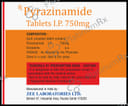Pyrazinamide
Uses
Pyrazinamide is used in the treatment of tuberculosis.
How it Works
How Pyrazinamide works Pyrazinamide is an antitubercular medication. In the body, it is converted to pyrazinoic acid. This pyrazinoic acid inhibits fatty acid synthase I, a bacterial enzyme that is essential for bacterial growth. Therefore, it acts as a bactericidal agent to inhibit their growth and treat tuberculosis.
Side Effects
Common side effects of Pyrazinamide include hepatitis (viral infection of the liver), joint pain, nausea, vomiting, and abdominal pain.
Expert Advice
- Pyrazinamide, in conjunction with other medications, effectively treats tuberculosis.
- Do not forget a dose, as this increases the risk of bacteria becoming resistant to the medication and heightens the risk of side effects.
- Your doctor may check your liver function before starting treatment and continue to monitor it regularly thereafter.
- Inform your doctor if you notice:
- Yellowing of the eyes or skin
- Dark urine
- Stomach pain
- Avoid drinking alcohol while taking Pyrazinamide, as this may increase the risk of liver-related side effects.
- Use a reliable contraceptive method (such as condoms or a diaphragm) to prevent pregnancy while taking Pyrazinamide, as it may reduce the effectiveness of hormonal contraceptives like the pill.
Other Combinations
Ethambutol + Isoniazid + Piperine + Pyrazinamide + Rifampicin
Ethambutol + Isoniazid + Pyrazinamide + Rifampicin + Vitamin B6 (Pyridoxine)
Ethambutol + Isoniazid + Pyrazinamide + Rifampicin
Isoniazid + Pyrazinamide + Rifampicin
Isoniazid + Pyrazinamide + Rifampicin + Vitamin B6 (Pyridoxine)
Related Medications
Pyrazinamide

MRP ₹32.6
Pyrazinamide

MRP ₹17.3
Pyrazinamide 500mg
MRP ₹51.2
Pyrazinamide 750mg

MRP ₹65
Pyrazinamide 500mg

MRP ₹40
Pyrazinamide 750mg

MRP ₹64.1
Pyrazinamide 750mg

MRP ₹47.5
Pyrazinamide 750mg

MRP ₹47.8
Pyrazinamide 750mg

MRP ₹25.3
Pyrazinamide 250mg

MRP ₹17
Pyrazinamide 750mg

MRP ₹53.6
Pyrazinamide 750mg

MRP ₹63
Pyrazinamide 750mg

MRP ₹49.5
Pyrazinamide 750mg

MRP ₹60
Pyrazinamide 500mg

MRP ₹27.8
Pyrazinamide 750mg

MRP ₹70
Pyrazinamide 500mg

MRP ₹17.1
Pyrazinamide 140mg

MRP ₹54
Pyrazinamide 750mg

MRP ₹35
Pyrazinamide 1000mg

MRP ₹96.9
Pyrazinamide 500mg

MRP ₹42.5
Pyrazinamide 750mg

MRP ₹76.9
Pyrazinamide 750mg

MRP ₹67.5
Pyrazinamide 1500mg

MRP ₹74.3
Pyrazinamide 750mg

MRP ₹60.2